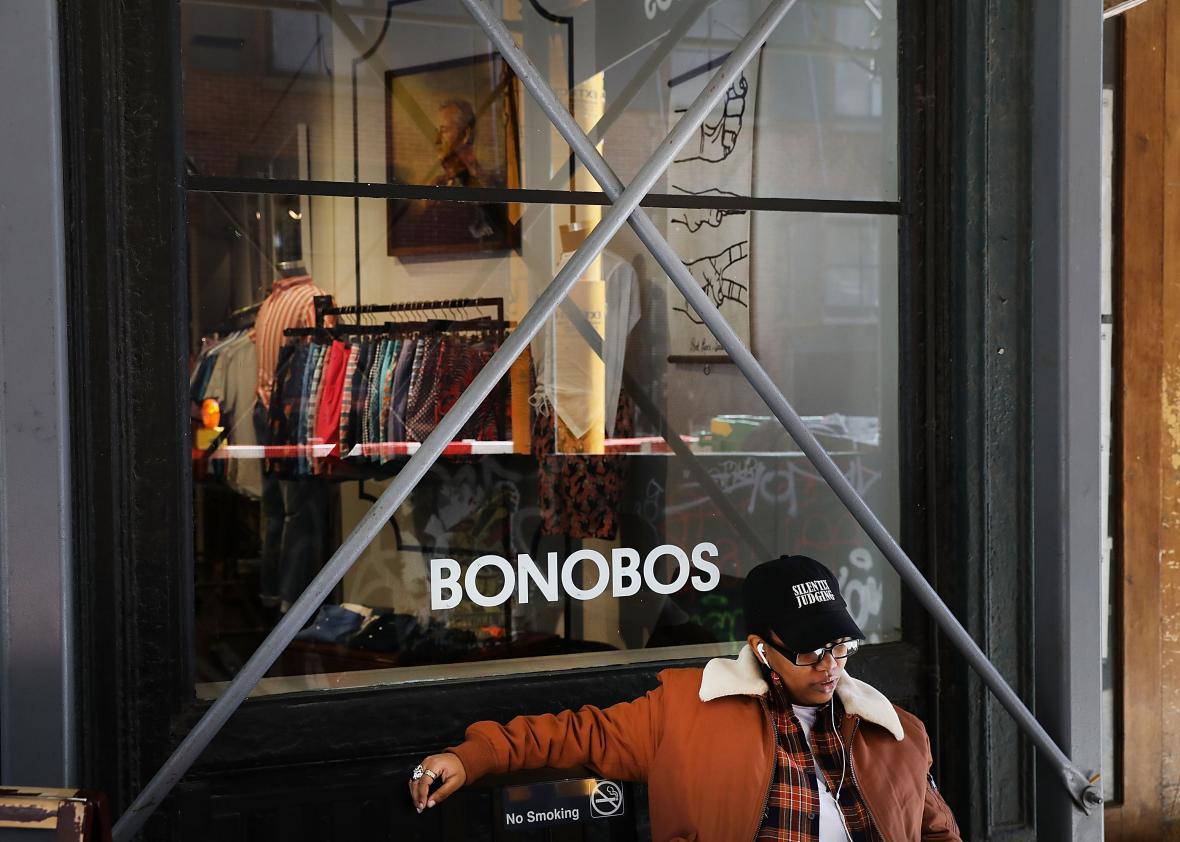On Friday morning, news broke that Walmart had purchased the menswear retailer Bonobos for $310 million. Arriving, as it did, in tandem with the announcement that Amazon had acquired Whole Foods for a far more astonishing figure, Walmart’s purchase threatened to become a footnote. Nevertheless, the Bonobos deal suggests an important story about the ways Walmart is striving to reach out into new markets—some of Amazon’s markets, in fact—especially when seen in light of some of its other recent moves.
Bonobos is just the latest in a series of online fashion acquisitions by Walmart. TechCrunch notes that since 2016 the company has purchased ModCloth, Moosejaw, Hayneedle, and Shoebuy, allowing it to massively expand on its existing array of Fruit of the Loom–esque basics. Almost in passing, the site observes that “Bonobos and other fashion purchases that Walmart has made … are not known for cut-price goods.” Duh. But it seems less likely that the company as a whole is moving up than that it is expanding outward, striving to reach new consumers—especially those who may have been turned off by its long-standing reputation.
As Neil Irwin writes in the New York Times, “Walmart’s move might seem a strange decision,” since Bonobos’ relatively expensive garments are pitched to a more upscale clientele than those sold in the mass market retailer’s many stores. Irwin rightly suggests that the move is part of the company’s ongoing struggle with Amazon to become “the predominant seller of pretty much everything you buy.” But if Walmart has lagged behind in that struggle, its difficulties may be about more than its digital strategy: Its trouble likely begins with its proletarian aura, associations that may make it hard to reach some valuable consumers.
On this front, Walmart stands to gain a great deal from its acquisition of brands such as Bonobos and ModCloth. The digital-first Bonobos has always traded on a combination of convenience and cool. Since its debut a decade ago, the company has promised men pants that fit better than those of its competitors. It maintains that promise today, telling visitors to its site, “We’ve made adjustments to ensure all our pants will fit you no matter your body type or style.” While that’s an appealing idea, it’s also faintly absurd: “A trimmer cut through the thigh” might work for some, but it’s bound to be hell on a seasoned dead-lifter. Likewise, a “curved waistband” is a nice feature, but it won’t do much to prevent “baggy seats” if you have a flat butt.
If those dubious promises have stuck for the company, though, it’s at least partly because they appeal to those who want to look good, but don’t want to put in much effort, and who are willing to pay a steep price for the luxury. To help persuade those who weren’t quite convinced, it advertised a crack team of customer service “Ninjas,” a groan-inducing term that seemed borrowed from Silicon Valley’s attempts to linguistically elevate otherwise mundane tasks. The message was clear, though: Bonobos was a company that kicked ass and threw shurikens—and they were going to make sure that you kicked ass too, even if you were all out of shurikens.
ModCloth’s appeal was different, but it played to similar impulses. As I’ve written in the past, it sold itself in part on the premise that it refuses to digitally alter photographs of its models. That body-positive attitude helped it claim that it was selling clothes for you, no matter who you are or what you look like. That, in its own turn, helped the company develop a fanatically loyal customer base prepared to buy its affordable—but not quite cheap—pocket dresses and colorful outerwear.
These are the kind of customers that Walmart needs to cultivate as it strives to expand its already considerable customer base—and, presumably, to improve its image as a crusher of mom-and-pops and a thwarter of decent working conditions. Among other things, it may mark an attempt to overcome partisan divides: Research tends to indicate that Walmart consumers swing right politically, which may speak to the company’s difficulty reaching left-leaning consumers. To be sure, Walmart’s reputation isn’t terrible, but as Forbes argued earlier this year, stocking more expensive brands may be linked to a trend that shows more Americans “graduating up out of the ‘middle class’ in income terms.” As they do, it may help the company to have a stable of friendlier sub-brands through whom it can reach out to otherwise inaccessible demographics.
If that’s Walmart’s endgame, it’s not making a show of the strategy. Visit ModCloth’s site today, and you’ll be hard-pressed to find a single mention of its relationship to Walmart, even on its “About Us” page. Much the same is true for Amazon competitor Jet.com, another recent Walmart acquisition, which cheerily announces on its “Vision and Values” page, “We share a sense of community with our shoppers and our partners, and we’re striving to create a business model that reflects that,” without acknowledging its corporate parent. For now, at least, Walmart’s gamble is presumably that it can scale up these already web-savvy brands, even as it siphons off just a bit of their hard-won fashionable charms.
